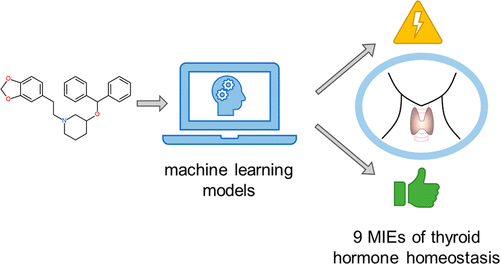当前位置:
X-MOL 学术
›
Chem. Res. Toxicol.
›
论文详情
Our official English website, www.x-mol.net, welcomes your feedback! (Note: you will need to create a separate account there.)
In Silico Models to Predict the Perturbation of Molecular Initiating Events Related to Thyroid Hormone Homeostasis
Chemical Research in Toxicology ( IF 4.1 ) Pub Date : 2020-11-13 , DOI: 10.1021/acs.chemrestox.0c00304 Marina Garcia de Lomana 1, 2 , Andreas Georg Weber 1 , Barbara Birk 1 , Robert Landsiedel 1 , Janosch Achenbach 1 , Klaus-Juergen Schleifer 1 , Miriam Mathea 1 , Johannes Kirchmair 2
Chemical Research in Toxicology ( IF 4.1 ) Pub Date : 2020-11-13 , DOI: 10.1021/acs.chemrestox.0c00304 Marina Garcia de Lomana 1, 2 , Andreas Georg Weber 1 , Barbara Birk 1 , Robert Landsiedel 1 , Janosch Achenbach 1 , Klaus-Juergen Schleifer 1 , Miriam Mathea 1 , Johannes Kirchmair 2
Affiliation

|
Disturbance of the thyroid hormone homeostasis has been associated with adverse health effects such as goiters and impaired mental development in humans and thyroid tumors in rats. In vitro and in silico methods for predicting the effects of small molecules on thyroid hormone homeostasis are currently being explored as alternatives to animal experiments, but are still in an early stage of development. The aim of this work was the development of a battery of in silico models for a set of targets involved in molecular initiating events of thyroid hormone homeostasis: deiodinases 1, 2, and 3, thyroid peroxidase (TPO), thyroid hormone receptor (TR), sodium/iodide symporter, thyrotropin-releasing hormone receptor, and thyroid-stimulating hormone receptor. The training data sets were compiled from the ToxCast database and related scientific literature. Classical statistical approaches as well as several machine learning methods (including random forest, support vector machine, and neural networks) were explored in combination with three data balancing techniques. The models were trained on molecular descriptors and fingerprints and evaluated on holdout data. Furthermore, multi-task neural networks combining several end points were investigated as a possible way to improve the performance of models for which the experimental data available for model training are limited. Classifiers for TPO and TR performed particularly well, with F1 scores of 0.83 and 0.81 on the holdout data set, respectively. Models for the other studied targets yielded F1 scores of up to 0.77. An in-depth analysis of the reliability of predictions was performed for the most relevant models. All data sets used in this work for model development and validation are available in the Supporting Information.
中文翻译:

用于预测与甲状腺激素稳态相关的分子起始事件扰动的计算机模型
甲状腺激素稳态的紊乱与不利的健康影响有关,例如甲状腺肿和人类的智力发育受损以及大鼠的甲状腺肿瘤。用于预测小分子对甲状腺激素稳态影响的体外和计算机模拟方法目前正在探索作为动物实验的替代方法,但仍处于早期发展阶段。这项工作的目的是为一组参与甲状腺激素稳态分子启动事件的目标开发一组计算机模型:脱碘酶 1、2 和 3、甲状腺过氧化物酶 (TPO)、甲状腺激素受体 (TR) 、钠/碘化物同向转运体、促甲状腺激素释放激素受体和促甲状腺激素受体。训练数据集来自 ToxCast 数据库和相关科学文献。结合三种数据平衡技术探索了经典统计方法以及几种机器学习方法(包括随机森林、支持向量机和神经网络)。这些模型接受了分子描述符和指纹的训练,并在保留数据上进行了评估。此外,研究了结合多个端点的多任务神经网络作为提高模型性能的一种可能方式,其中可用于模型训练的实验数据有限。TPO 和 TR 的分类器表现特别好,在保持数据集上的 F1 分数分别为 0.83 和 0.81。其他研究目标的模型产生高达 0.77 的 F1 分数。对最相关的模型进行了预测可靠性的深入分析。
更新日期:2020-11-13
中文翻译:

用于预测与甲状腺激素稳态相关的分子起始事件扰动的计算机模型
甲状腺激素稳态的紊乱与不利的健康影响有关,例如甲状腺肿和人类的智力发育受损以及大鼠的甲状腺肿瘤。用于预测小分子对甲状腺激素稳态影响的体外和计算机模拟方法目前正在探索作为动物实验的替代方法,但仍处于早期发展阶段。这项工作的目的是为一组参与甲状腺激素稳态分子启动事件的目标开发一组计算机模型:脱碘酶 1、2 和 3、甲状腺过氧化物酶 (TPO)、甲状腺激素受体 (TR) 、钠/碘化物同向转运体、促甲状腺激素释放激素受体和促甲状腺激素受体。训练数据集来自 ToxCast 数据库和相关科学文献。结合三种数据平衡技术探索了经典统计方法以及几种机器学习方法(包括随机森林、支持向量机和神经网络)。这些模型接受了分子描述符和指纹的训练,并在保留数据上进行了评估。此外,研究了结合多个端点的多任务神经网络作为提高模型性能的一种可能方式,其中可用于模型训练的实验数据有限。TPO 和 TR 的分类器表现特别好,在保持数据集上的 F1 分数分别为 0.83 和 0.81。其他研究目标的模型产生高达 0.77 的 F1 分数。对最相关的模型进行了预测可靠性的深入分析。


























 京公网安备 11010802027423号
京公网安备 11010802027423号